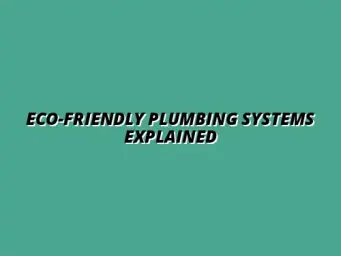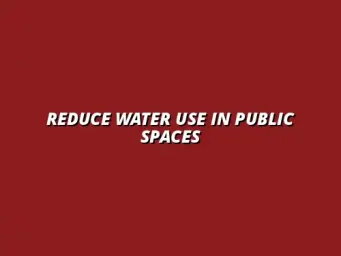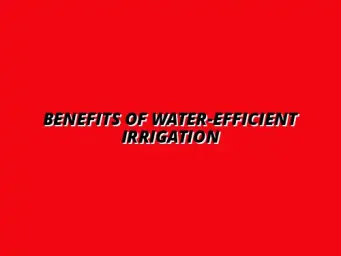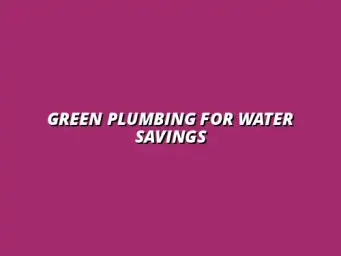Understanding Low-Flow Toilets and Their Mechanisms
Low-flow toilets are designed to use significantly less water than traditional toilets, usually using 1.6 gallons or less per flush. This is a big shift from older models that can use as much as 3.5 to 7 gallons per flush! Understanding how these toilets work can help you see their value in water conservation and cost savings.
These toilets are often equipped with advanced features that help them maintain effective flushing power while consuming less water. They rely on a combination of gravity, pressure, and innovative design to ensure waste is efficiently removed from the bowl. Let’s dive deeper into what makes these toilets unique!
Defining Low-Flow Toilets and Their Functionality
When we talk about low-flow toilets, we refer to a specific type of toilet that minimizes water usage without sacrificing performance. Low-flow toilets are designed not just to save water, but to function effectively within the constraints of lower water volumes. This makes them a smart choice for eco-conscious homeowners! If you're considering installing one yourself, check out this helpful guide on installing a toilet.
The main goal of these toilets is to reduce the amount of freshwater used for flushing waste. Many models achieve this through various technologies, ensuring they still flush efficiently. Now, let's explore the features that classify a toilet as low-flow!
What Makes a Toilet Low-Flow?
There are several key features that define a low-flow toilet:
- Flush volume: Uses 1.6 gallons per flush or less.
- Efficient design: Optimized bowl shapes and trapways to enhance waste removal.
- Pressure-assisted systems: Some models use pressurized air to assist flushing.
- Dual-flush options: Provides the choice between a full or partial flush depending on the situation.
These features work together to ensure that low-flow toilets can still perform their essential function while saving water. Understanding these elements is crucial when choosing a toilet for your home!
How Low-Flow Toilets Operate Compared to Traditional Models
Low-flow toilets operate differently than traditional toilets, primarily in their flushing mechanisms. Traditional toilets rely on gravity to pull water down into the bowl, but low-flow models often incorporate additional technologies for improved efficiency. This means they can achieve a strong flush without needing excessive water.
In a low-flow toilet, the water is often released in a more concentrated manner, which helps in effectively clearing waste. This is a fascinating change that benefits both the user and the environment! Now, let's look at some more details about the operation of low-flow toilets compared to traditional ones. For further tips on reducing water waste in your home, check out these water-saving tips.
- Water pressure: Low-flow toilets can work with lower water pressure, yet still flush effectively.
- Flush timing: Advanced models can complete a flush in a shorter time span.
- Design innovation: New technologies allow for better waste and water management.
By understanding how low-flow toilets operate, you can see why they are a practical choice for modern bathrooms. They not only save water but also demonstrate how innovation can lead to sustainable living!
The Role of Low-Flow Toilets in Water Conservation
Low-flow toilets play a significant role in conserving water, which is becoming increasingly important in today’s world. As we face challenges like droughts and water shortages, every drop counts. Installing low-flow toilets can make a big difference in reducing overall water consumption! Learn more about green plumbing for water savings.
Focusing on conservation means being responsible not only for our own water use but also for the local ecosystems that depend on healthy water levels. So, let's delve into how much water these toilets can actually save.
Quantifying Water Savings with Low-Flow Toilets
One of the most impressive benefits of low-flow toilets is their ability to significantly cut down on water usage. By switching to low-flow models, households can expect to see substantial savings on their water bills. Here are some key statistics:
- Annual savings: A single low-flow toilet can save approximately 13,000 gallons of water per year.
- Household impact: For a family of four, this translates to about 52,000 gallons saved yearly!
- Community-wide effects: If a community collectively adopts low-flow toilets, the impact can be enormous.
Understanding these numbers highlights the importance of making the switch to low-flow toilets. They aren't just good for individual households; they contribute to broader water conservation efforts as well! For daily tips on reducing water waste, visit this page.
Statistics on Water Usage: Low-Flow vs. Traditional Toilets
To put these savings into perspective, let’s compare water usage between low-flow and traditional toilets. Traditional toilets can use:
- 3.5 to 7 gallons per flush for older models.
- 1.6 gallons per flush for newer, more efficient designs.
In contrast, low-flow toilets consistently use 1.6 gallons or less, showcasing a marked difference! This shift helps put less pressure on our water supply, benefiting everyone.
Real-World Examples of Water Savings
Numerous cities and communities have adopted low-flow toilets, leading to impressive water savings. Here are some real-world examples:
- San Francisco: Implemented a city-wide initiative to replace older toilets; projected savings of over 1 million gallons per day!
- Los Angeles: Estimated annual water savings of over 12 billion gallons through low-flow toilet installations.
These case studies demonstrate the effectiveness of low-flow toilets in real-life situations. When communities come together to embrace water-saving technologies, the results can be remarkable!
Addressing Common Misconceptions About Low-Flow Toilets
When it comes to low-flow toilets, there are many myths that can cloud our understanding. One of the biggest concerns people have is whether these toilets perform as effectively as traditional models. The truth is, low-flow toilets have come a long way in technology and design, and they often work just as well, if not better, than older versions. Let’s explore some of these performance concerns and the advancements that have been made!
Many individuals worry that a low-flow toilet won't flush away waste properly. However, this assumption is often unfounded. Modern low-flow toilets use advanced flushing mechanisms that increase the velocity of water flow, ensuring a reliable flush every time. Not only do they conserve water, but they also keep your bathroom clean and functional! If you need plumbing assistance in Birmingham, consider contacting a plumber in Billesley, Birmingham.
Performance Concerns: Do Low-Flow Toilets Work Effectively?
One common misconception is that low-flow toilets lack the power needed for a strong flush. However, with advancements in flushing technology, many models are designed to provide a powerful flush with significantly less water. Let's break down some of the myths surrounding flush power:
- Myth: Low-flow toilets clog more often than traditional toilets.
- Myth: They require multiple flushes to dispose of waste.
- Myth: They don’t handle solid waste effectively.
In reality, many low-flow models are engineered with features like dual-flush systems that offer a low-volume option for liquid waste and a higher volume for solid waste. This not only maximizes water savings but also enhances overall performance.
Advancements in design, such as wider trapways and better bowl shapes, contribute to more effective waste removal. As you can see, technology is continually improving to meet our needs while being environmentally responsible!
Debunking Myths Regarding Flush Power and Reliability
Let’s further debunk some specific myths regarding the reliability of low-flow toilets. Many households still believe that these toilets aren't dependable. Here are some key points to consider:
- Modern low-flow toilets often have a higher flush rating than older traditional models.
- Many are equipped with pressure-assisted flushing systems for enhanced performance.
- Testing has shown that they can handle waste just as effectively as standard toilets.
These features help ensure that low-flow toilets are not only efficient but also reliable, putting to rest the concerns people may have regarding their functionality.
Technology Advances Enhancing Low-Flow Performance
Low-flow toilets have benefitted greatly from technological advancements. Innovations like smart flushing systems are becoming more common, which can detect the type of waste and adjust the water used accordingly. This means that you're not just saving water; you’re also using the right amount for each flush! Regular maintenance of your water heater is crucial for efficiency; here are some annual water heater inspection tips.
Furthermore, advancements in materials and design have made these toilets more durable and easier to maintain. The combination of these technologies makes low-flow toilets a smart choice for any home.
Maintenance and Care Tips for Low-Flow Toilets
To keep your low-flow toilet functioning at its best, routine maintenance is essential. Proper care not only extends its lifespan but also ensures optimal performance. Here are some maintenance practices to consider:
- Check for leaks regularly.
- Clean the toilet bowl with appropriate cleaners to avoid mineral build-up.
- Inspect the flush mechanism for any signs of wear and tear.
By following these simple steps, you can help your low-flow toilet remain in top shape and ready to save water while performing effectively! Prevent kitchen sink blockages with these easy tips: Prevent Kitchen Sink Blockages.
Routine Maintenance Practices to Ensure Longevity
Routine maintenance can make a big difference in the lifespan of your low-flow toilet. Here are some additional tips:
- Adjust the water level in the tank to avoid too much or too little water being used per flush.
- Use a toilet tank bank or similar device to save even more water.
- Replace worn components promptly to maintain flushing efficiency.
Keeping your toilet in good working order can save you both water and money. Take care of it, and it will take care of you!
Common Issues and Troubleshooting Tips
As with any appliance, low-flow toilets can encounter issues from time to time. Some common problems include:
- Toilet not flushing fully.
- Water continuously running.
- Hissing noises from the tank.
If you experience any of these issues, check the flapper and ensure the tank is filling properly. Sometimes, a simple adjustment can solve the problem. If not, don't hesitate to consult a professional for help!










